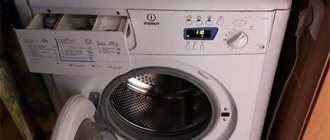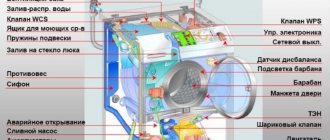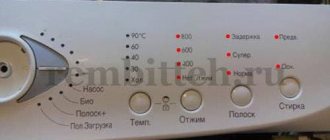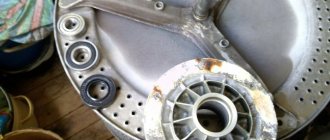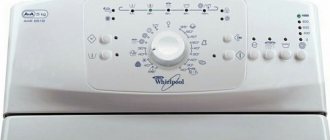Thermal sensor is a special device that controls the heating of water in the drum. It monitors the desired temperature and turns off the heater in time to save energy. If suddenly your appliance stops heating water or takes too much time to do so, it may be this sensor. Let's find out how to check the functionality of the temperature sensor in a washing machine.
Location of the sensor in the washing machine
Purpose and types of temperature sensors
The task of this element of the washing machine circuit is to control the temperature of the water in the tank. The sensor measures parameters in real time, transmits information to the control module, which in turn analyzes the data and, if necessary, gives the command to turn on the heating element.
Modern washing machines can be equipped with three types of sensors. Each of them has its own characteristics, advantages and disadvantages. These are: a bimetallic element, a gas-filled temperature sensor and an electronic thermistor sensor.
Bimetallic element
This is a purely mechanical device. The moving element of the sensor is a plate made of two metals, one of which has a significantly higher coefficient of thermal expansion. When the set temperature is reached, the plate bends and closes or opens the contacts.
Exactly the same element is used in irons, cheap convectors and other heating equipment with a temperature measurement function. The sensor is simple and fairly reliable, but has low accuracy and often fails due to oxidation of the contacts.
Gas-filled sensor
A temperature sensor of this type consists of a sensor itself with a sealed tube filled with gas, a temperature controller and a conductor that connects them. The sensor is installed in the tank; when the temperature changes, pressure arises, which acts on the membrane, closes and opens the contacts, turning the heating element on and off. Such temperature sensors are found in older Indesit washing machines.
This temperature sensor is distinguished by a fairly high accuracy of temperature measurement, but it is difficult to manufacture and prone to breakdowns. The slightest damage to the tube leads to a complete loss of functionality and the need to replace the sensor.
Thermistor
Unlike previous types, this is a completely electronic element. In modern washing machines, it has almost completely replaced mechanical parts. Found in almost all washing machines Samsung, Bosch and others. The temperature sensor is easy to change (it is installed directly next to the heating element). Structurally, it is a metal cylinder with a diameter of about 10 mm. There is a connection block for connecting to the wiring.
The operation of a temperature sensor is based on the effect of reducing its resistance when the ambient temperature changes. The absence of moving elements ensures a long service life, and electronic filling guarantees high accuracy of indicators.
Where is the thermostat located and how does it work?
In most models of washing machines, the thermistor is located in the heating element and has a cylindrical shape with a circumference of 10 mm. In some washing machines, the thermistor can be installed separately from the heater directly in the tank in a place provided by the design, and have the shape of a tablet with a diameter of 25-30 mm.
It directly contacts one part with the water in the tank to obtain an indication of the existing temperature of the liquid. Wires are connected to the second, outer part of the sensor, transmitting readings from the electronic component to the electronic unit.
Electronic temperature sensors transmit data to the control unit in the form of resistance readings, which change depending on the level of water heating. The processor converts sensor resistance readings into temperature parameters and controls the timely shutdown of the heater.
Older machines were equipped with gas thermostats. They were made in the form of a thin metal tube with gas, on one side of which there was a tip in contact with water, and on the other a temperature regulator.
The power supply to the heating element in such a sensor was turned off due to a change in pressure when the water was heated. These thermostats had a rather complex design and were subsequently replaced by their electronic counterparts, which had a simple design and the lowest cost.
Symptoms of a faulty temperature sensor
Most automatic washing machines from renowned manufacturers, for example, Bosch, can themselves detect a malfunction of the temperature sensor. If it breaks down, a code is displayed on the display, which allows you to accurately identify the source of the malfunction. In addition, the following symptoms indicate sensor failure.
- When performing any program, the water temperature rises to almost boiling.
- Body parts get hot, and in some cases steam appears in the area of the loading hatch.
- The heating element does not turn on, the washing machine does not heat the water at all.
The appearance of an error code on the screen, as well as any of the signs of failure described above, is a reason to start repairs. You should not delay, since a violation of the temperature regime entails not only damaged laundry, but also damage to a number of parts of the washing machine.
“Symptoms” of problems with thermistor
The natural operation of the Indesit machine directly depends on the serviceability of the temperature detection sensor. A malfunction can also be identified by external signs:
- Regardless of the selected washing mode, the water in the tank is heated to maximum temperature;
- The body of the machine heats up until hot steam comes out.
Under such circumstances, it is necessary to very quickly replace the temperature sensor on the Indesit washing machine so that the heating element does not fail. Replacing the sensor costs much less than the cost of the heating element, so you need to hurry to fix the problem.
Interesting:
- How to disassemble a Zanussi washing machine
- Bosch dishwasher errors
- How to check the temperature sensor of a washing machine
- Error codes for AEG washing machines
- How to fix error F08 on a Whirlpool washing machine
- How to repair a Samsung washing machine
Reader comments
- Share your opinion - leave a comment
Partial disassembly of the washing machine
The temperature sensor measures the temperature of the water in the tank, therefore, it is attached to its body. To gain access to it, you will need to partially disassemble the washing machine. The easiest way to work is with new models in which the sensor is a thermistor; to check and replace it, just remove the back panel.
Before starting work, you must unplug the washing machine from the socket. Next, disconnect the inlet and outlet hoses. They need to be handled with care; there is probably some water left inside that could spill onto the floor.
The washing machine is moved away from the wall; it is better to place it in the middle of the room. The work is performed according to the following algorithm:
- Unscrew the screws holding the back wall;
- remove the panel, put it aside;
- loosen the screw holding the heating element;
- remove the temperature sensor.
This instruction is relevant in the case of a washing machine with a thermistor, these are new models Samsung, Ariston, Indesit and others. Finding and retrieving sensors in older washing machines has its own characteristics, which will be discussed below.
Washing machine temperature sensor Ariston, Indesit (for drying) 098739
The list of models may be incomplete. To easily search for a model from the list, use the browser search function (combination of 2 keys Ctrl + F ) Ariston:
AMD109EU AMD109EU (80305920000) AMD109EU (80305920051) AMD109EU (80305920052) AMD109EU (80305920900) AMD109EU (80305920905) AMD129EU AMD129EU (8030589000) 0) AMD129EU (80305890051) AMD129EU (80305890052) AMD129EU (80305890900) AMD129EU (80305890905) AMD145FR AMD145FR (80300080000) AMD145FR (80300080051) ) AMD145FR (80300080900) AMD145FR (80300080905) AMD149DE AMD149DE (80303670000) AMD149DE (80303670051) AMD149DE (80303670900) AML101AG AML101AG (80305800) 000) AML101AG (80305800050) AML101AG (80305800051) AML101AG (80305800900) AML105EX AML105EX (80305820000) AML105EX (80305820050) AML105EX ( 80305820051) AML105EX (80305820900) AML105K60HZ AML105K60HZ (80305850051) AML105K60HZ (80305850900) AML119TK AML119TK (80305880000) AML119TK (8 AML125AUS (80305910000) (80305910051) AML125AUS (80305910900) AML125AUS (80305911000) AML125EX AML125EX (80305900000) AML125EX (80305900050) AML125EX (80305900051) AML125EX (80305900900) AML125FR AML1 25FR (80300070000) AML125FR (80300070050) AML125FR (80300070051) AML125FR (80300070052) AML125FR (80300070900) AML125FR (80300070905) AML129EU AML129EU (80305980000) AML129EU (80305980050) AML129EU (80305980051) AML129EU (80305980052) AML129EU (80305980900) AML129EU (80305980905) AML135FR AML13 5FR (80319780000) AML135FR (80319780050) AML135FR (80319780051) AML135FR (80319780900) AML135FR (80319780905) AML80AG AML80AG (80322500000) AML80AG (80322500051) AML80AG (80322500900) AML81AG AML81AG (80305780050) AML81AG (80305780051) AML81AG (80305780900) AML85EX AML85EX (80305760000) AML85EX ( 80305760050) AML85EX (80305760051) AML85EX (80305760900) AML89EU AML89EU (80305960000) AML89EU (80305960050) AML89EU (80305960051 ) AML89EU (80305960052) AML89EU (80305960900) AML89EU (80305960905) AMXXF149EU AMXXF149EU (94377270000) AMXXF149FR AMXXF149FR (94377280000) AMXXL120FR AMXXL120FR (94377250000) AMXXL129EU AMXXL129EU (94377260000) AWD121NA AWD121NA (80353560000) AWD121NA (80353560900) AWD129NA AWD129NA (80422060000) CDE129ALL CDE129ALL ( 80325700000) CDE129ALL (80325700900) CDE129ALL (80325700905) CDE129ALL/HA CDE129ALL/HA (80518110000)
Indesit:
MLSE129ALL MLSE129ALL (80332390000) MLSE129ALL (80332390900) MLSE129ALL (80332390905) MLSE129ALL (80332391005) WD2000SNA WD2000SNA (80328580000) WD2000SNA (80328580900) WDD960PUK WDD960PUK (94547420100) WDL520PUK.K WDL520PUK.K (94568710100) WDL540GUK WDL540GUK (94547350100) WIDE126DE WIDE126DE (80319820000) WIDE126DE (80319820051) WIDE126DE (80319820900) WIDE127UK WIDE127UK (80305630000) WIDE127UK (80305630051) WIDE127UK (80305630900) WIDE146DE WIDE146DE (803923) 90000) WIDL102UK WIDL102UK (80305360000) WIDL102UK (80305360051) WIDL102UK (80305360900) WIDL102UK (80305361500) WIDL106AUS WIDL106AUS (8032305000) 0) WIDL106AUS ( 80323050051) WIDL106AUS (80323050900) WIDL106EX WIDL106EX (80319660000) WIDL106EX (80319660051) WIDL106EX (80319660900) WIDL106EX60HZ WIDL106EX60HZ ( 80332040000) WIDL106EX60HZ (80332040051) WIDL106EX60HZ (80332040900) WIDL126CH WIDL126CH (80350530000) WIDL126CH (80350530900) WIDL126DE WIDL126DE (803 19800000) WIDL126DE (80319800051) WIDL126DE (80319800900) WIDL126EX WIDL126EX (80305700000) WIDL126EX (80305700051) WIDL126EX (80305700900) WIDL126FR WIDL126FR (80305340100) WIDL126FR (80 305340151) WIDL126FR (80305340900) WIDL126SDE WIDL126SDE (80319810000) WIDL126SDE (80319810051) WIDL126SEX WIDL126SEX (80319830000) WIDL126SEX (8031983 0051) WIDL126SUK WIDL126SUK (80305590000) WIDL126SUK (80305590051) WIDL126SUK (80305591500) WIDL126UK WIDL126UK (80305380000) WIDL126UK (80305380900) WIDL126UK (8030538150) 0) WIDL126UK (80336800000) WIDL126UK (80336800051) WIDL126UKPMC WIDL126UKPMC (80305380000) WIDL126UKPMC (80305380900) WIDL126UKPMC (80305381500) WI DL126UKPMC (80336800000) WIDL126UKPMC (80336800051) WIDL146DE WIDL146DE (80319790000) WIDL146DE (80319790051) WIDL146DE (80319790900) WIDL146EX WIDL146EX (80305730000) WIDL146EX (803057300) 51) WIDL146EX (80305730900) WIDL146FR WIDL146FR (80366870000) WIDL146UK WIDL146UK (80305670000) WIDL146UK (80305670051) WIDL146UK (80305670900) WIDL1 46UK (80305671500 ) WIDL86EX WIDL86EX (80319650000) WIDL86EX (80319650051) WIDL86EX (80319650900)
Thermistor check
The electronic temperature sensor changes resistance when the ambient temperature changes, this is exactly what you should make sure of. You need a multimeter to work. You need to do the following:
- disconnect the wires from the sensor;
- remove it from the socket;
- switch the device to the resistor testing position;
- check the resistance with a multimeter (the normal value at room temperature will be about 6 kOhm);
- lower the thermistor into hot water;
- re-measure.
At approximately 50 degrees, the thermistor resistance should be below 1.5 kOhm. If the value is constant or if the device shows a “gap”, the sensor is changed. Installation is carried out in the reverse order, the back wall of the washing machine is attached last.
If a breakdown is not detected, the cause of the malfunction may be a burnt heating element.
Gas-filled and bimetallic thermostats
The gas-filled thermostat consists of two parts:
- metal washer (tablets),
- copper tube.
The sensor is filled with freon. This gas changes its state when the water temperature changes, causing the contacts going to the heating element to close or open.
The washer is located in the washing machine tub, the copper tube is attached to the control panel.
A bimetallic thermostat also resembles a tablet, but works by changing the position of a special plate. When the plate bends, the contacts close.
The gas-filled thermostat is the only temperature sensor that can be repaired (the rest cannot be repaired, only replaced with new ones).
, the copper tube is usually . The gas evaporates, escaping through small holes and cracks. If the damage to the tube is minor, the tightness is restored, and the tube itself is filled with freon again.
They check such a thermostat by filling it with freon and observing whether it comes out of the tube. Such a check is carried out by a professional master.
The bimetallic temperature sensor fails due to wear of the plate over time. This thermostat is checked in test mode.
First, a special device (multimeter) measures its resistance at room temperature, and then in a heated state (the device is first lowered into hot water).
If in the first and second cases the multimeter shows approximately the same values, the bimetallic temperature sensor is faulty. A working sensor in a heated state has much lower resistance.
The non-working bimetallic temperature sensor is replaced with a new one.
To remove the thermostat from the washing machine, you will need to partially disassemble it (remove the back cover and front panel) and remove the sensor through the hole in the tank (pull off the insulation, sealing rubber and disconnect the wires).
After installing the new temperature sensor, the washing unit is assembled in the reverse order.
It is also better to entrust such repairs to a professional technician who has special knowledge, experience and tools.
Call a VseRemont24 service center specialist to your home at any time convenient for you! He will quickly and efficiently check, repair or replace any thermostat with a new one!
Removing and checking the gas-filled temperature sensor
Owners of an older Indesit or LG washing machine may encounter another type of sensor, the working part of which is a tube filled with gas. To remove and check such a temperature sensor, you will first have to dismantle the front panel of the machine and disconnect the regulator.
Further, along the wires coming from the regulator, it is easy to detect the sensor itself. It is mounted on the drum, but the exact installation location depends on the manufacturer and model; before starting work, you should read the disassembly manual for your specific washing machine.
To check this temperature sensor, you also need a multimeter. It is transferred to the “ringing” mode. Set the temperature switch to 45-50 degrees. The sensor is immersed in hot water and the moment of contact activation is recorded.
The faulty temperature sensor is replaced. Sensors and kits that also include a regulator are sold separately. It is better to change the pair, this will guarantee a long service life of the washing machine and protect against unscheduled repairs.
Diagnostics and replacement of temperature sensors
Washing machine thermostat replacement tool:
- Phillips screwdriver;
- flat screwdriver;
- 10 mm socket wrench;
- tester;
- waterproof glue or silicone.
To replace the thermostat in your washing machine, you need to find out where the thermostat is installed. On most models it is located under the back cover along with the heating element (at the bottom of the drum). But, for example, on Bosh and Siemens machines the thermostat is located behind the front panel, and to dismantle it you need to remove the top and front panels. The installation location of the temperature sensor on your machine can be clarified in documents or on the Internet.
Replacing a gas-filled thermostat
Sequence of operations:
- disconnect the machine from the network;
- drain the water from the tank;
- unscrew the screws and remove the cover;
- loosen the heating element fastening with a key;
- take a photo of the connection diagram before removing the power wires from the thermostat;
- carefully remove the thermostat with a flat screwdriver, being careful not to damage the rubber seal;
- remove the temperature regulator from the control panel;
- inspect the installation site and, if necessary, treat with sealant or glue;
- Install the new thermostat in reverse order;
- turn on the machine and check the operation of the thermostat in heating mode up to 40 degrees.
Replacing a bimetallic thermostat
Subsequence:
- disconnect the machine from the network;
- drain the water from the tank;
- remove the cover;
- loosen the heating element fastening with a key;
- take a photo of the connection diagram before removing the power wires from the thermostat;
- remove the thermostat;
- measure resistance with a tester at room temperature;
- Place the thermostat in hot water and measure the resistance again. If the measurement result does not change or changes slightly, the sensor should be replaced;
- installing the thermostat is done in the reverse order;
- turn on the machine and check the operation of the thermostat in heating mode up to 40 degrees.
Replacing the thermistor
Subsequence:
- disconnect the machine from the network;
- drain the water from the tank;
- remove the cover;
- loosen the heating element fastening with a key;
- take a photo of the connection diagram before removing the power wires from the thermistor;
- remove the thermistor, measure the resistance with a tester and compare with the nominal value for a given machine model;
- install and connect the new thermistor in the reverse order;
- turn on the machine, check the operation of the thermistor in heating mode up to 40 degrees.
Attention! All work should be carried out only after disconnecting the machine from the network!
Checking the bimetallic element
Sometimes you can encounter mechanical type temperature sensors; the procedure for checking them is similar to the procedure for working with gas-filled sensors, but the difficulty lies in finding and removing the element itself.
Exactly as in the previous case, the sensor is removed, tested for contact, and then immersed in hot water. By the way, a bimetallic temperature sensor can be checked without a multimeter. Due to its design, it clicks quite loudly when triggered, however, it is better to use the device; often the sensor does not trigger due to oxidation of the contacts, this cannot be determined by ear.
Despite the obvious complexity of a modern automatic washing machine, most of its breakdowns can be fixed independently. Replacing the temperature sensor is no exception. It is easy to check and replace if necessary. It is important only to buy original replacement sensors; an attempt to save money may become a reason for repeated repairs.

